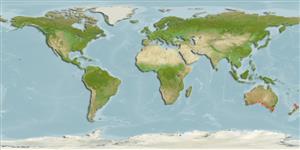Actinopterygii (ray-finned fishes) >
Perciformes (Perch-likes) >
Sparidae (Porgies)
Etymology: Acanthopagrus: Greek, akantha = thorn + Greek, pagros, a kind of fish (Ref. 45335).
Environment / Climate / Range
Ecology
Marine; freshwater; brackish; demersal. Subtropical, preferred ?; 27°S - 44°S
Indo-Pacific: endemic to southern Australia.
Length at first maturity / Size / Weight / Age
Maturity: Lm ?, range 16 - ? cm
Max length : 60.0 cm TL male/unsexed; (Ref. 2156); common length : 24.0 cm TL male/unsexed; (Ref. 2156); max. published weight: 4.0 kg (Ref. 26523); max. reported age: 29 years (Ref. 36820)
Dorsal
spines
(total): 10 - 13;
Dorsal
soft rays
(total): 10-13;
Anal
spines: 3;
Anal
soft rays: 8 - 10. The upper body can vary from silvery to golden brown, bronze, green or black depending on habitat. Chin and belly are usually white and fins are dusky to greenish black. Dorsal and ventral profiles of adults are similarly convex.
Endemic in coastal areas, rivers and estuaries of Australia. Most abundant in river mouths and estuaries (Ref. 28468, 28472). Inhabit brackish waters of coastal rivers and lakes, occasionally penetrating fresh water (Ref. 44894). Considered as the only true estuarine sparid in Australia. Larvae and small juveniles are most abundant over seagrass beds in shallow estuarine waters (Ref. 28468, 28472). Spawning period varies considerably between estuaries (Ref. 28468). Remain upstream in sheltered waters to spawn and is not usually found in purely marine habitats (Ref. 44894). Feed on shellfish, worms, crustaceans, small fish and algae. Sold as whole, chilled products in domestic markets (Ref. 6390). One of top angling species in southern Australia (Ref. 6390, 44894), as well as being a delicious table fish (Ref. 2156).
It is not known whether there is any sex inversion in black bream (Ref. 6390).
Kailola, P.J., M.J. Williams, P.C. Stewart, R.E. Reichelt, A. McNee and C. Grieve, 1993. Australian fisheries resources. Bureau of Resource Sciences, Canberra, Australia. 422 p. (Ref. 6390)
IUCN Red List Status (Ref. 115185)
CITES (Ref. 94142)
Not Evaluated
Threat to humans
Harmless
Human uses
Fisheries: commercial; gamefish: yes
More information
ReferencesAquacultureAquaculture profileStrainsGeneticsAllele frequenciesHeritabilityDiseasesProcessingMass conversion
Tools
Special reports
Download XML
Internet sources
